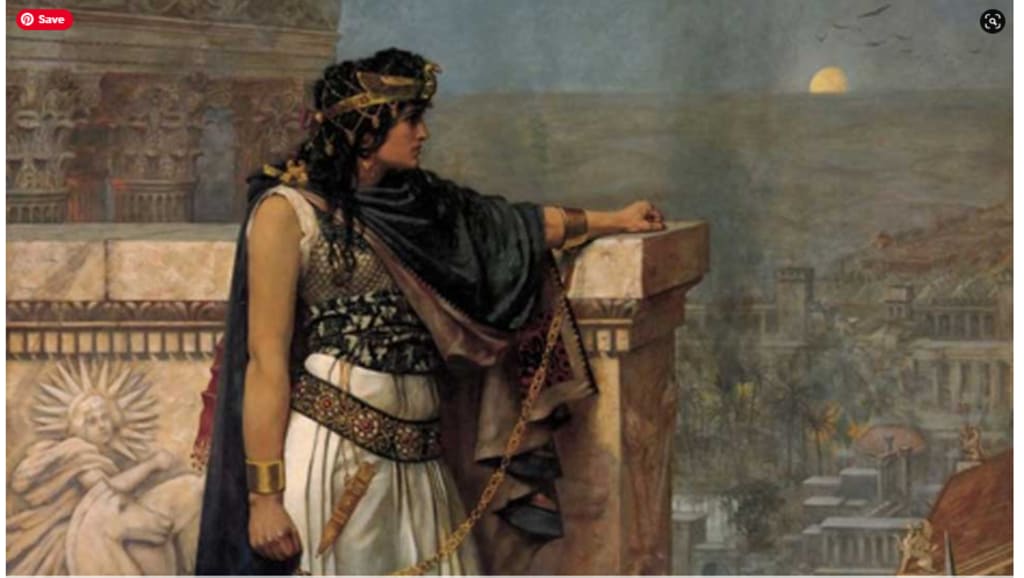Did Cleopatra VII's Offspring Live and Give Birth to the fabled Queen Zenobia of Palmyra?
How Cleopatra’s Daughter Survived…and Throve

Four children were born to Cleopatra VII, the final pharaoh of an independent Egypt: Ptolemy Philadelphia, twins Alexander Helios and Cleopatra Selene, and Caesarian (with Julius Caesar) (the latter three with Mark Antony). However, she only bore a single daughter, Selene, who wed King Juba II of Mauretania, and so had no other offspring.
Selene most likely had two offspring of her own before her lineage vanished from view. However, two centuries later, Zenobia, the Syrian Queen of Palmyra (who subjugated Egypt in the third century AD), claimed ancestry from Cleopatra. Could it be that Cleopatra's lineage endured and flourished to confront her long-standing rival, Rome?
How Cleopatra's Daughter Managed to Live...and Succeed
Emperor Augustus's client king Juba ruled over his kingdom of Mauretania (which was not distant from Juba's ancestral country of Numidia) while Cleopatra Selene was his wife. This was a calculated move on the part of Juba, as Selene was practically a member of the imperial family, having been reared by Augustus's adored sister Octavia (wife of their father Antony) and her complete siblings following their mother's suicide.
It appears that Cleopatra Selene, who wed Juba sometime between 25 and 19 BC, governed alongside her spouse. They transformed the city of Mauretania into a Greco-Roman utopia.
In addition to utilizing her royal lineage by naming her son Ptolemy, who controlled Mauretania after his father, Cleopatra also struck coins bearing her name, with Jububa featured on them. Suetonius's Life of the Caesars history of Caligula claims that the eccentric emperor did not treat his friends or family well.
Among them was "Ptolemy, son of King Juba, his cousin," who was his first cousin once removed and "rewarded for [his] kinship and for...loyal services with a brutal death." When Ptolemy entered the stage for a gladiatorial spectacle, Caligula saw that Ptolemy's magnificent purple robe drew attention from onlookers, and for no other reason than that, he killed Ptolemy. Sadly, he passed in the late 30s or early 40s AD, he had no known descendants.
Retroactive Husband-Swapping
Juba and Selene might have had a daughter, possibly called Drusilla, in addition to Ptolemy. Tacitus describes Drusilla as "the granddaughter of Cleopatra and Antony" who wed Antonius Felix, the procurator of Judea and a freedman of Emperor Claudius, who was also a grandson of Antony.
It is unclear from the Jewish-turned-Roman historian Josephus' account that Felix was wed to a different Drusilla, who was the daughter of Judean Agrippa I.
Were these two women of the same name confused by Tacitus? Felix is said by Suetonius to have married "three queens," suggesting that more than one of them bore the name Drusilla. At the time, this was not an unusual nickname, as Drusilla was the Julio-Claudians' family name.
Additionally, under Roman rule, royals were likely to name their children after the imperial family in homage to their overlords. Some argue that Drusilla of Mauretania was the granddaughter of Selene and Juba, who had a son named Ptolemy, rather than the daughter of the couple.
In any case, how did Drusilla, who was married to a Roman official, become known as "Queen Regina," as Suetonius calls her? Maybe after Felix she married a king. The ruler in question was most likely Gaius Julius Sohaemus, the king of the well-known Syrian city-state Emesa. The affairs of his brother Azizus's wife, Drusilla, the previously mentioned Felix's wife, brought the family to the notice of the world.
Josephus claims that Felix compelled Drusilla of Judea to divorce her husband since he was in love with her, which meant that Felix would also have to divorce Drusilla. It is not implausible to think that Drusilla of Judea's brother-in-law was married to Drusilla of Mauretania.
She would have become Emesa's queen in the process. Wikipedia states that Drusilla unquestionably wed Sohaemus and had children with him, perpetuating Cleopatra's ancestry through the ages, although that assertion is far from validated.
This theory becomes even more logical when one takes into account the possible identity of the mother of Ptolemy's daughter Drusilla of Mauretania, who was Cleopatra Selene's granddaughter.
Though there is little evidence, it appears that Ptolemy's wife was named Julia Urania. Although nothing is known about her, a French historian has noted that the name "Urania" is associated with members of the ruling class in—wait for it—Emesa! Drusilla's mother was a princess of Emesa, it would be fitting for her daughter to remarry into the same royal family as her mother.
Cleopatra's Allegations
Drusilla might have given birth to heirs to her royal ancestress through either her first marriage to Felix or her second marriage to Sohaemus. Any children born to Felix might also have married into the royal dynasty of Emema: As seen by the marriage of Drusilla, daughter of Agrippa I, to King Azizus of Emesa, the nobles of Judea frequently had children with members of the Emesa royal line.
Guess what name their daughter had when Azizus's sister, Princess Iotape, married Aristobulus, the brother of the previously mentioned Agrippa? Oh, Drusilla.
Furthermore, it is quite possible that the offspring of Drusilla and King Sohaemus of Emesa married into the Palmyra royal dynasty, who live nearby and are roughly 160 kilometers (99 mi) from modern Homs (historical Emesa).
In Julia Domna: Syrian Empress, Barbara Levick writes about a Roman empress who was born in Emesa, noting that "Emesa was closely linked for its prosperity with its neighbor Palmyra." As a result, Zenobia, queen of Palmyra, may have had Cleopatra as "the founder of her family," as she claimed, which was documented in the Historia Augusta.
The two cities most likely solidified their alliances through dynastic marriage. Alternatively, it could have been her spouse, King Odaenathus, who derived directly from her.
Zenobia preserved Cleopatra's heritage in addition to acknowledging her as an ancestor. Under the pen name "Cleopatra," the writer Callinicus of Petra—who most likely resided at the Palmyrene court—wrote a ten-book history of Alexandria, the capital city of Egypt, and dedicated it to Zenobia.
Female Pioneers: The Ascent to Power of Queen Zenobia and Cleopatra VII
Whether they are related or not, these two female leaders have a lot in common. Both Cleopatra VII and Zenobia were strong female leaders with political influence who broke social conventions of the day to become influential individuals in political environments dominated by men.
These female leaders opposed the Roman Empire's growing power. Famously, Zenobia led the uprising against Roman control and triumphantly overran Egypt before the Roman Emperor Aurelian ultimately vanquished her. Meanwhile, Cleopatra sided with Mark Antony and Julius Caesar.
Each of the queens zealously promoted their cultural heritage by assuming these leadership responsibilities. The final Egyptian pharaoh, Cleopatra VII, made it her goal to adopt Greek and Ptolemaic cultural customs. As Palmyra's queen, Zenobia drew attention to the Greek aspects of her reign and equated herself with the mythological Cleopatra.
However, does Zenobia's claim to be a descendant of Cleopatra imply that they were indeed linked by blood? Maybe this was just political spin, used to support her conquest of Egypt, in part. By doing this, she positioned herself as the most powerful woman of her day and a true Hellenistic Greek king, ruling a state that owed little to no allegiance to its Western overlord—in this case, Cleopatra himself. Despite nominally ruling for their brothers or sons at times, both queens held independent power over cities at the crossroads of trade in the east and had to contend with Rome's encroachment on their much-loved domain.






Comments
There are no comments for this story
Be the first to respond and start the conversation.